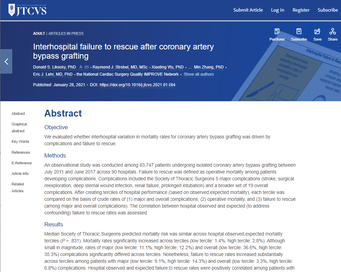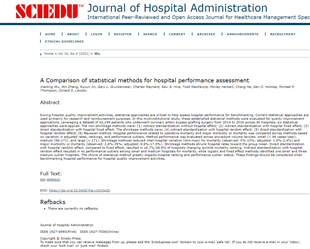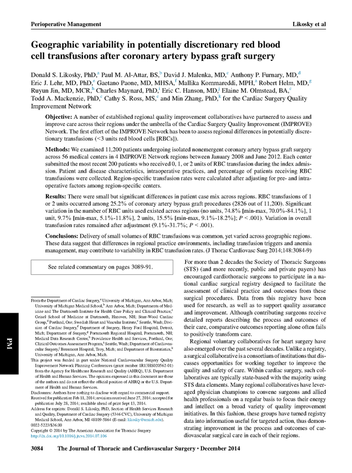Geographic variability in potentially discretionary red blood cell transfusions after coronary artery bypass graft surgery
Published December of 2014 in the Journal of Thoracic and Cardiovascular Surgery
|
OBJECTIVE: A number of established regional quality improvement collaboratives have partnered to assess and improve care across their regions under the umbrella of the Cardiac Surgery Quality Improvement (IMPROVE) Network. The first effort of the IMPROVE Network has been to assess regional differences in potentially discretionary transfusions (<3 units red blood cells [RBCs]).
METHODS: We examined 11,200 patients undergoing isolated nonemergent coronary artery bypass graft surgery across 56 medical centers in 4IMPROVE Network regions between January 2008 and June 2012. Each center submitted the most recent 200 patients who received 0, 1, or 2 units of RBC transfusion during the index admission. Patient and disease characteristics, intraoperative practices, and percentage of patients receiving RBC transfusions were collected. Region-specific transfusion rates were calculated after adjusting for pre- and intraoperative factors among region-specific centers. RESULTS: There were small but significant differences in patient case mix across regions. RBC transfusions of 1 or 2 units occurred among 25.2% of coronary artery bypass graft procedures (2826 out of 11,200). Significant variation in the number of RBC units used existed across regions (no units, 74.8% [min-max, 70.0%-84.1%], 1 unit, 9.7% [min-max, 5.1%-11.8%], 2 units, 15.5% [min-max, 9.1%-18.2%]; P < .001). Variation in overall transfusion rates remained after adjustment (9.1%-31.7%; P < .001). CONCLUSIONS: Delivery of small volumes of RBC transfusions was common, yet varied across geographic regions. These data suggest that differences in regional practice environments, including transfusion triggers and anemia management, may contribute to variability in RBC transfusion rates. |
Interhospital Failure to Rescue After Coronary Artery Bypass Grafting
Published January of 2021 in the Journal of Thoracic and Cardiovascular Surgery
Published January of 2021 in the Journal of Thoracic and Cardiovascular Surgery

Likosky DS; Strobel RJ; Wu X; Kramer RS; Hamman BL; Brevig JK; Thompson MP; Ghaferi AA; Zhang M; Lehr EJ and the National Cardiac Surgery Quality IMPROVE Network. Interhospital Failure to Rescue After Coronary Artery Bypass Grafting. J Thorac Cardiovasc Surg. 2021 Jan 29;S0022-5223(21)00163-X. doi: 10.1016/j.jtcvs.2021.01.064. Online ahead of print. PMID: 33712236.
OBJECTIVE We evaluated whether interhospital variation in mortality rates for coronary artery bypass grafting was driven by complications and failure to rescue.
METHODS An observational study was conducted among 83,747 patients undergoing isolated coronary artery bypass grafting between July 2011 and June 2017 across 90 hospitals. Failure to rescue was defined as operative mortality among patients developing complications. Complications included the Society of Thoracic Surgeons 5 major complications (stroke, surgical reexploration, deep sternal wound infection, renal failure, prolonged intubation) and a broader set of 19 overall complications. After creating terciles of hospital performance (based on observed:expected mortality), each tercile was compared on the basis of crude rates of (1) major and overall complications, (2) operative mortality, and (3) failure to rescue (among major and overall complications). The correlation between hospital observed and expected (to address confounding) failure to rescue rates was assessed.
RESULTS Median Society of Thoracic Surgeons predicted mortality risk was similar across hospital observed:expected mortality terciles (P = .831). Mortality rates significantly increased across terciles (low tercile: 1.4%, high tercile: 2.8%). Although small in magnitude, rates of major (low tercile: 11.1%, high tercile: 12.2%) and overall (low tercile: 36.6%, high tercile: 35.3%) complications significantly differed across terciles. Nonetheless, failure to rescue rates increased substantially across terciles among patients with major (low tercile: 9.1%, high tercile: 14.3%) and overall (low tercile: 3.3%, high tercile: 6.8%) complications. Hospital observed and expected failure to rescue rates were positively correlated among patients with major (R2 = 0.14) and overall (R2 = 0.51) complications.
CONCLUSIONS The reported interhospital variability in successful rescue after coronary artery bypass grafting supports the importance of identifying best practices at high-performing hospitals, including early recognition and management of complications.
OBJECTIVE We evaluated whether interhospital variation in mortality rates for coronary artery bypass grafting was driven by complications and failure to rescue.
METHODS An observational study was conducted among 83,747 patients undergoing isolated coronary artery bypass grafting between July 2011 and June 2017 across 90 hospitals. Failure to rescue was defined as operative mortality among patients developing complications. Complications included the Society of Thoracic Surgeons 5 major complications (stroke, surgical reexploration, deep sternal wound infection, renal failure, prolonged intubation) and a broader set of 19 overall complications. After creating terciles of hospital performance (based on observed:expected mortality), each tercile was compared on the basis of crude rates of (1) major and overall complications, (2) operative mortality, and (3) failure to rescue (among major and overall complications). The correlation between hospital observed and expected (to address confounding) failure to rescue rates was assessed.
RESULTS Median Society of Thoracic Surgeons predicted mortality risk was similar across hospital observed:expected mortality terciles (P = .831). Mortality rates significantly increased across terciles (low tercile: 1.4%, high tercile: 2.8%). Although small in magnitude, rates of major (low tercile: 11.1%, high tercile: 12.2%) and overall (low tercile: 36.6%, high tercile: 35.3%) complications significantly differed across terciles. Nonetheless, failure to rescue rates increased substantially across terciles among patients with major (low tercile: 9.1%, high tercile: 14.3%) and overall (low tercile: 3.3%, high tercile: 6.8%) complications. Hospital observed and expected failure to rescue rates were positively correlated among patients with major (R2 = 0.14) and overall (R2 = 0.51) complications.
CONCLUSIONS The reported interhospital variability in successful rescue after coronary artery bypass grafting supports the importance of identifying best practices at high-performing hospitals, including early recognition and management of complications.
A Comparison of statistical methods for hospital performance assessment.
Published May of 2021 in the Journal of Hospital Administration
Published May of 2021 in the Journal of Hospital Administration

Abstract
During hospital quality improvement activities, statistical approaches are critical to help assess hospital performance for benchmarking. Current statistical approaches are used primarily for research and reimbursement purposes. In this multiinstitutional study, these established statistical methods were evaluated for quality improvement applications. Leveraging a dataset of 42,199 patients who underwent coronary artery bypass grafting surgery from 2014 to 2016 across 90 hospitals, six statistical approaches were applied. The non-shrinkage methods were: (1) indirect standardization without hospital effect; (2) indirect standardization with hospital fixed effect; (3) direct standardization with hospital fixed effect. The shrinkage methods were: (4) indirect standardization with hospital random effect; (5) direct standardization with hospital random effect; (6) Bayesian method. Hospital performance related to operative mortality and major morbidity or mortality was compared across methods based on variation in adjusted rates, rankings, and performance outliers. Method performance was evaluated across procedure volume terciles: small (< 96 cases/year), medium (96-171), and large (> 171). Shrinkage methods reduced inter-hospital variation (min-max) for mortality (observed: 0%-10%; adjusted: 1.5%-2.4%) and major morbidity or mortality (observed: 2.6%-35%; adjusted: 6.9%-17.5%). Shrinkage methods shrunk hospital rates toward the group mean. Direct standardization with hospital random effect, compared to fixed effect, resulted in 16.7%-38.9% of hospitals changing quintile mortality ranking. Indirect standardization with hospital random effect resulted in no performance outliers among small and medium hospitals for mortality, while logistic and fixed effect methods identified one small and three medium outlier hospitals. The choice of statistical method greatly impacts hospital ranking and performance outlier’ status. These findings should be considered when benchmarking hospital performance for hospital quality improvement activities.
During hospital quality improvement activities, statistical approaches are critical to help assess hospital performance for benchmarking. Current statistical approaches are used primarily for research and reimbursement purposes. In this multiinstitutional study, these established statistical methods were evaluated for quality improvement applications. Leveraging a dataset of 42,199 patients who underwent coronary artery bypass grafting surgery from 2014 to 2016 across 90 hospitals, six statistical approaches were applied. The non-shrinkage methods were: (1) indirect standardization without hospital effect; (2) indirect standardization with hospital fixed effect; (3) direct standardization with hospital fixed effect. The shrinkage methods were: (4) indirect standardization with hospital random effect; (5) direct standardization with hospital random effect; (6) Bayesian method. Hospital performance related to operative mortality and major morbidity or mortality was compared across methods based on variation in adjusted rates, rankings, and performance outliers. Method performance was evaluated across procedure volume terciles: small (< 96 cases/year), medium (96-171), and large (> 171). Shrinkage methods reduced inter-hospital variation (min-max) for mortality (observed: 0%-10%; adjusted: 1.5%-2.4%) and major morbidity or mortality (observed: 2.6%-35%; adjusted: 6.9%-17.5%). Shrinkage methods shrunk hospital rates toward the group mean. Direct standardization with hospital random effect, compared to fixed effect, resulted in 16.7%-38.9% of hospitals changing quintile mortality ranking. Indirect standardization with hospital random effect resulted in no performance outliers among small and medium hospitals for mortality, while logistic and fixed effect methods identified one small and three medium outlier hospitals. The choice of statistical method greatly impacts hospital ranking and performance outlier’ status. These findings should be considered when benchmarking hospital performance for hospital quality improvement activities.

